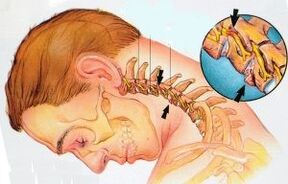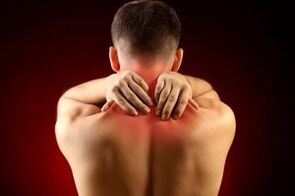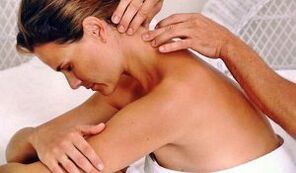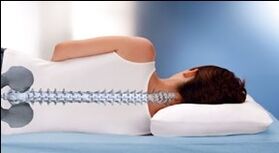
The question: How to treat osteochondrosis of the cervical spine, there is one answer: to influence the cause of this disease if you are not an acute period.
Medicine treats the study - symptoms of the disease, not the cause.Therefore, do not hope for doctors, do not throw money on ointments, teas, injections, physiotherapy, simulators, massage.None of the funds listed will help you.
So it is categorical to say that my personal experience in the treatment of cervical osteochondrosis, which I will be glad to share in the hope that it will help one of you to deal with this problem.
However, success in treatment will depend on several conditions:
- Your desire to help yourself;
- willingness to understand the true cause of cervical osteochondrosis;
- Observing the most self -discipline in treatment.
What do you need to know about the osteochondrosis of the cervical spine
To answer the question:How to treat osteochondrosis of the cervical spine,It is necessary to understand the cause of the disease well.To understand it, you will need to turn to the anatomy of the spine.
Our spine is a strong but flexible case for vital blood vessels and nerve trunks.Spinal support in good condition means not having health problems.
But we, of ignorance or because of a frivolous attitude to health from a young age, casually heal the spine: too load, take uncomfortable poses, sitting for hours on the computer or on the table during sitting work, spend a lot of time driving a car in a tense state, we have overweight, incorrect stand.

The spine is the most movable.It consists of seven vertebrae, between which there are elastic intervertebral discs.They are clearly visible in the figure.The discs make the spine flexible and at the same time give it strength.
Each intervertebral disc consists of a fibrous ring inside which there is a pulpulated nucleus.
In the cervical spine, the cerebrospinal nerve and vertebrae pass, which, through the branched nerves and blood vessels, feed not only with the head with the brain but also the organs of the shoulder girdle.
Cervical osteochondrosis is a change in the intervertebral discs of the cervical spine as a result of physical, inflammatory or mental exposure.The elasticity and strength of the intervertebral discs decrease, while their height also decreases.
In the future, if you do not cure the disease, the fibrous ring of the intervertebral disc is drained and deformed, which can lead to convexity.In more severe cases, the fibrous ring of the disc is broken and the pulpitic nucleus protrudes in the form of hernias as they squeeze the nerve endings resulting from the spinal openings, as shown in the figure.
So, the cause of cervical osteochondrosis is a change in the intervertebral discs in the cervical spine against the background of weak muscles.In addition, even mild muscle tension can lead to the displacement of the vertebrae, resulting in the nerve endings compressed and pain occurs.
But there are many factors that cause a change in the disks.It is a sedentary lifestyle and hereditary predisposition, metabolic disorders, and injuries, and the deposition of salts in the cervical spine and others.
How is osteochondrosis manifesting cervical osteochondrosis?All symptoms indicate that the innervation and blood supply to the brain, head, neck and shoulders are impaired as a result of changes in the intervertebral discs.Therefore, the symptoms of cervical osteochondrosis are headache in the back of the head and temples, Dizziness with a sharp head turn, tinnitus, reduction of visual acuity, worsening of hearing, neck pain, shoulders, shoulder blades, hands and sometimes in the heart.
Dizziness with a sharp head turn, tinnitus, reduction of visual acuity, worsening of hearing, neck pain, shoulders, shoulder blades, hands and sometimes in the heart.
If cervical osteochondrosis is not treated, then due to impaired cerebral circulation, diseases such as migraines, hypertension, vegetation of dystonia, hearing problems, eyes, coordination, cardiovascular and respiratory systems develop.In advanced cases, brain ischemia and stroke can develop.
Personal experience in the treatment of cervical osteochondrosis
The diagnosis is cervical osteochondrosis, I was given a neuropathologist at the age of 45.After looking at the X-ray of my neck, he wrote on the map to the diagnosis: the height of the discs between the C5-C6 and the C6-C7 vertebrae is significantly reduced.I was tormented by a frequent headache, I called in my ears, neck pain.
The question arose:How to treat osteochondrosis of the cervical spine.The doctor calmly "reassured" me that osteochondrosis is impossible to cure completely, as the intervertebral discs were deformed.He prescribed me not cheaply, at these prices, ointment and advised me to sit directly at the table.It was the 90s, I bought the ointment according to the recipe for a neuropathologist in some left pharmacy.But they are oily relief does not bring, the pain poisoned my life.
On the recommendation of acquaintances, I turned to the services of a paid specialist in manual therapy with higher medical education.After he could feel the cervical vertebrae turned my head turned, it seemed to be 180 degrees, it became easy, enlightened and not painful.However, the procedure was obviously dangerous.The manalist warned that in three days you should sit directly on the table, not in your favorite posture.

I followed the recommendations for two days and then forgot.A few days later, my condition again became the same as before visiting a manualist.This experience told me how to treat osteochondrosis of the cervical spine.After reading all the literature on osteochondrosis, I realized that I needed to influence the cause of the disease independently.The doctors here are not assistants.It is impossible to change the deformation of the discs, but you can stretch the cervical spine and thus reduce the pressure on the nerve endings and blood vessels.
In the house we always had a horizontal bar, in the morning hanging on it, you get a good stretch of the whole spine except for the neck.I tried many ways to stretch my neck and develop my own system for the treatment of cervical osteochondrosis:
- Changed your posture.It wasn't easy and it didn't happen immediately, but just -discipline and my motivation helped me feel healthy.I often looked in the mirror towards my stand, checked it, going near the wall: my head should touch the wall, that is, to be on the same heel line.I always try to hold my head and shoulders straight.Today, when I am 60, I have a pose better than twenty years ago.
- I do the turtle exercise daily from the Tao revitalization system.Sometimes I do it more often if I feel tension or hardening in the neck, upper back or shoulders.Make the turtle of the turtle with a sitting as in the figure:
- Lower your chin on your chest, pulling your head up with your back with your head.Inhale slowly.At that time, the back of the neck extends upwards and the shoulders are lowered;
- Slowly exhale, take the back of your head as if you want to touch them to the back of the neck.The chin extends up, the throat extends slightly.The shoulders rise on both sides of the head, as if they were about to touch the ears;
- Repeat this cycle 10-12 times, trying to do everything slowly.
Turtle exercise contributes to the safe stretching of the cervical spine, strengthens the muscles of the neck and shoulders, eliminates fatigue, hardening and pain, improves metabolism and rejuvenates the body.
- In addition to the Turtle, I do an exercise to relax the entire belt of the shoulder, also sit:
- Lift and lower your shoulders 10 times;Tilt your head slowly to the left - right 10 times on each shoulder;
- Tilt your head slowly back - back 10 times;
- Tilt your head first to the right (right ear to right shoulder), then slowly, standing out your neck and throwing your head, roll it to the spine and left shoulder.Then from the left shoulder - to the right.Make 10 breaks on each shoulder;
- Relax, straighten your spine again, balance the body weight on the tail, and start slowly making circular movements with torso from left to right, then 10 times from right to left.At the same time, the head, the shoulders, the arms are relaxed.
This exercise, in addition to relaxation, awakens the healing forces of the body, normalizing the energy nutrition of all cells and organs.
- When I work on the computer for a long time, I put a collar on my neck (it can be purchased at a pharmacy).I don't sit in it for a long time, an hour or two.This allows you to keep your head straight.
- If I noticed that from an uncomfortable posture, for example, sitting next to the TV or working in the country, I had a ring in my ears or headaches, I immediately relax (as I read here), then do the turtle exercise.Call and pain go away within 5-10 minutes.

The relaxation and stretching of the neck muscles and the shoulder girdle should become part of your daily routine, then you will feel great by having such a diagnosis as osteochondrosis of the cervix.
Consult your doctor before starting exercises.
I would like to point out here that such treatment of the disease is possible beyond exacerbation.If you have an acute period of cervical osteochondrosis with impaired nerves of hypothermia or any infection, then see a doctor and take the prescribed blockade, injections, etc.As soon as the exacerbation has passed, you can apply my method.
You are also a note: you can relax the muscles on your neck by taking a hot shower on your neck or grabbing in the bath.
Live a mobile lifestyle, but avoid sharp turns of your head, severe weight, as the shoulder muscles are strained, whose spasm will displace the vertebrae and disrupt the roots of the nerves and blood vessels in the neck.
Sleep on a small pillow, often in the fresh air, change the negative thoughts to the positive ones so that your tensions do not strain the cervical and shoulder areas and do not exacerbate the symptoms of osteochondrosis.

Stick to proper nutrition.Exclude sugar and white bread, bread products from your diet.Eat more vegetables, fruits and grain.
Now I hope you understand how to treat osteochondrosis of the cervical spine.
Trust yourself and live without pain with your cervical osteochondrosis!






















